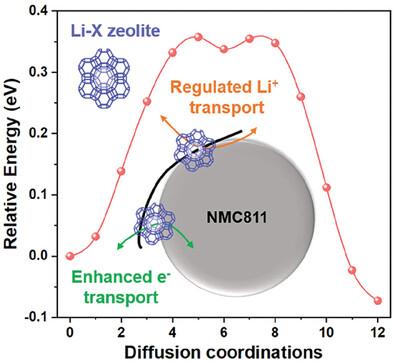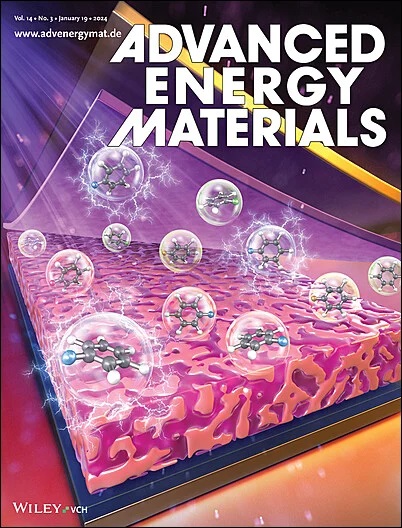设计基于锂交换沸石的多功能电极添加剂,用于超高负载电极,以实现高能量密度的锂金属电池
IF 24.4
1区 材料科学
Q1 CHEMISTRY, PHYSICAL
引用次数: 0
摘要
高能量密度电池的实用化要求电极在超高活性物质负载的情况下具有良好的性能。然而,随着电极厚度的增加,电极中的离子传输明显受到限制,从而限制了 Li+ 的扩散动力学和活性物质的利用率。本研究通过 Li+ 交换策略合成了锂离子交换沸石 X(Li-X 沸石),以增强 Li+ 扩散动力学。在超高负载阴极中加入 Li-X 沸石后,它具有:i) 高电子传导性,通过降低曲折度形成均匀的网络;ii) 良好的离子传导性,这归功于 Li-X 的锂+扩散调制;iii) 高弹性,可防止颗粒级开裂和电极级崩解。此外,固/液界面上的 Li-X 沸石有利于形成稳定的阴极电解质界面,从而有效抑制副反应并减轻过渡阳离子的溶解。因此,通过干电极技术制造出了超高负载(66 mg cm-2)的阴极,在锂金属电池中显示出了 12.7 mAh cm-2 的显著磁场容量和 464 Wh kg-1 的高能量密度。精心设计的电极结构以多功能 Li-X 沸石作为厚阴极的添加剂,有望提高电池的速率能力、循环稳定性和整体能量密度。本文章由计算机程序翻译,如有差异,请以英文原文为准。

Design Lithium Exchanged Zeolite Based Multifunctional Electrode Additive for Ultra‐High Loading Electrode Toward High Energy Density Lithium Metal Battery
The practicalization of a high energy density battery requires the electrode to achieve decent performance under ultra‐high active material loading. However, as the electrode thickness increases, there is a notable restriction in ionic transport in the electrodes, limiting the diffusion kinetics of Li+ and the utilization rate of active substances. In this study, lithium‐ion‐exchanged zeolite X (Li‐X zeolite) is synthesized via Li+ exchange strategy to enhance Li+ diffusion kinetics. When incorporated Li–X zeolite into the ultra‐high loading cathodes, it possesses i) high electron conductivity with a uniform network by reducing tortuosity, ii) decent ion conductivity attributes to modulated Li+ diffusivity of Li‐X and iii) high elasticity to prevent particle‐level cracking and electrode‐level disintegration. Moreover, Li–X zeolite at the solid/liquid interface facilitates the formation of a stable cathode electrolyte interface, which effectively suppresses side reactions and mitigates the dissolution of transition cations. Therefore, an ultra‐high loading (66 mg cm−2 ) cathode is fabricated via dry electrode technology, demonstrating a remarkable areal capacity of 12.7 mAh cm−2 and a high energy density of 464 Wh kg−1 in a lithium metal battery. The well‐designed electrode structure with multifunctional Li–X zeolite as an additive in thick cathodes holds promise to enhance the battery's rate capability, cycling stability, and overall energy density.
求助全文
通过发布文献求助,成功后即可免费获取论文全文。
去求助
来源期刊

Advanced Energy Materials
CHEMISTRY, PHYSICAL-ENERGY & FUELS
CiteScore
41.90
自引率
4.00%
发文量
889
审稿时长
1.4 months
期刊介绍:
Established in 2011, Advanced Energy Materials is an international, interdisciplinary, English-language journal that focuses on materials used in energy harvesting, conversion, and storage. It is regarded as a top-quality journal alongside Advanced Materials, Advanced Functional Materials, and Small.
With a 2022 Impact Factor of 27.8, Advanced Energy Materials is considered a prime source for the best energy-related research. The journal covers a wide range of topics in energy-related research, including organic and inorganic photovoltaics, batteries and supercapacitors, fuel cells, hydrogen generation and storage, thermoelectrics, water splitting and photocatalysis, solar fuels and thermosolar power, magnetocalorics, and piezoelectronics.
The readership of Advanced Energy Materials includes materials scientists, chemists, physicists, and engineers in both academia and industry. The journal is indexed in various databases and collections, such as Advanced Technologies & Aerospace Database, FIZ Karlsruhe, INSPEC (IET), Science Citation Index Expanded, Technology Collection, and Web of Science, among others.
 求助内容:
求助内容: 应助结果提醒方式:
应助结果提醒方式:


